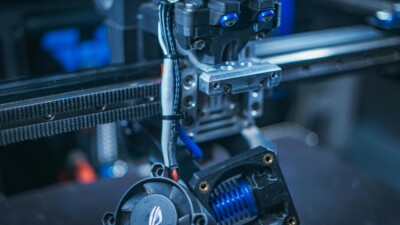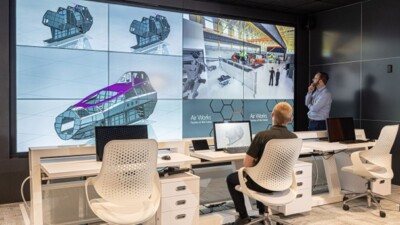Dassault Systèmes’ Michael Buchli on how manufacturing SMEs can turn shopfloor information into winning business strategies.
This video is brought to you by Dassault Systèmes.
Advanced manufacturing the post Covid era is all about advanced technology, used to make Europe and America competitive with low-wage Asian economies. Aggregate in understanding the vast amounts of shopfloor data generated by modern production processes is key to high-level production efficiency needed to stay competitive today. Manufacturing expert Mike Buchli explains the problems and solutions with engineering.com’s Jim Anderton.
Industry 4.0 is more than connectivity. It’s a new way to manufacture better products faster, and lower cost with higher quality. Learn more here about integrated, intelligent manufacturing.
Transcript:
Jim Anderton:
Hello everyone and welcome to Manufacturing the Future. There’s a manufacturing renaissance happening in Europe and America today, born out of broken supply chains due to COVID-19, as well as new production technologies that make traditionally high wage economies cost competitive with low wage jurisdictions. Now, small and medium-sized enterprises have historically been at a disadvantage compared to large companies who have the resources to implement advanced technologies, but this situation is changing. There’s a new generation of software and systems that let smaller enterprises aggregate, process and act on data to increase efficiency and lower costs just like the large players.
Mike Buchli:
Well, I mean that’s a whole discussion in itself, right? The differences between the large and the small, but I think when you really truncate it down, it’s really two things. It’s the speed at which they have to do business and it’s the available time that they have to try new things.
Jim Anderton:
You mentioned that time factor. There’s a time valued information, and one thing I noticed, and I visit a lot of shops large and small, is that there’s an new generation of equipment. Process equipment itself, there’s process monitoring equipment, there’s quality equipment now, in process inspection, we’re doing things on the line that we used to do in the front office, for example. We’re generating a vast amount of data, and this data can overwhelm an organization that simply can’t afford to have a dedicated engineer to do nothing but analyze this stuff. How do they get around that?
Mike Buchli:
Yeah, it’s an interesting thing, because like you I sit on lots of calls and people are like, well, maybe we should hire data analysts now. Maybe that’s the wave of the future. I’m a small shop with 10 people. I need a data analyst. And the reality is there’s a lot of confusion going on, and there’s also a lot of challenges what to do with that data. Because traditionally what has happened, and we’ve seen this over and over and over in the middle market or the small manufacturer is a big company adopts this tech, and then they try to push it down to the suppliers, and eventually it pushes down to the lower end groups. But there’s never really an explanation of why any of that information has value. So, when we start looking at data collection. Data collection’s been around, gosh, I remember dealing with it in 2001, 2002.
Jim Anderton:
If you’re General Motors, you have the luxury of being able to simply rip a factory out to the bare walls and then basically rebuild a line from scratch. The vast majority of SMEs especially, you can’t afford to do that. So, there’s a spectrum of equipment on a production floor, some of which is brand new, some of which can be legacy equipment that’s quite old, often multiple different suppliers, manufacturers of equipment. Each one these days seems to ship with a proprietary package within the machine’s firmware. So, everyone says we can log uptime and downtime. We’re logging these critical machine attributes and you’ve got to get all these different things all to play nice and to talk together, otherwise you’re going to have one hell of a bottleneck at the front office. Do you see that as an issue?
Mike Buchli:
Yeah, it does become an issue, and if you think about it, you have to think about who’s trying to sell you what? And this is one of the analogies I have is if I’m having a problem with efficiency and I go talk to my machine tool dealer, he’s going to tell me I need a new machine, because he’s selling the machine and he’s going to want to sell his software to go with that machine because he wants to lock you into every machine being his machine. But the problem that we have here is small companies can’t afford just to buy a fleet of equipment and connect it together, and more importantly from that is the problem with productivity may not be the machine. The problem with productivity may be all of your disconnected processes before the machine’s ever turned on, but when you’re only talking to a machine tool dealer or you’re only talking to a tooling vendor or a CMM dealer, you’re only getting what they want to sell you, which is piecemeal.
Jim Anderton:
Two common mistakes that I have seen over and over again and tell me if you see this yourself. One is SMEs basically that go for the big shiny thing and they blow the budget on hardware and there’s nothing left for support equipment, nothing left for training, nothing left for software essentially. And then they’re scrambling to extract the full productivity available from the hardware because they overspent on the front end. And the second one I see is the situation where they chase the big score, that giant OEM contract and they win. It’s wonderful, and now it’s, oh damn, I have to actually produce and I don’t have the productive capability to do this. Then it’s a panic buy of buying the equipment without that necessary sort of homework to make sure that you know what you’re getting because they just don’t have time. They got to get up and running. Do you see that still exists?
Mike Buchli:
Yeah, that is a huge challenge that we see with stuff of, I’ll give you an example of a company. They’re buying a $2 million tube laser. They already allotted to buy the tube laser, but they haven’t done any factory organization to figure out where that tube laser is going to go on their plant. It’s coming, it’s on its way, but they didn’t figure out where it goes. So, now they’re looking at, well, we’ll just pull out all of these steel racks that support the laser and we’ll put it right there. The problem is now you’ve just tripled your material flow and it’s sitting by a door that’s open all year round.
Jim Anderton:
You brought up robots, so I’m glad you did. It’s robotic, especially machine tending in the environments we’re talking about here. Common application. And there are two ways to approach this. One is that you can buy a manufacturing cell. Typically an integrator is involved and they are cross shopping between the robot vendors, for example, the ancillary equipment makers and say the core five axis mill or the laser or whatever the core machine is. The other way to do it is to sort of do a piecemeal basically, and that’s when you’re doing that in-house or you’re hiring an outside consultant who says, “I recommend you use a TRUMPF laser. I recommend you use a FANUC robot basically, and we’re going to make it all work in a custom application just for you.” Those are two different approaches to the same problem. I’ve seen them both. I’ve seen them both work. I’ve seen them both not work. Do you see the same factors out there? Is there one better way to do this?
Mike Buchli:
It’s an interesting thing because we have lots of integrators. We have lots of people that build it their own. The biggest challenge that comes into play with both of them, and it’s a common problem, is if I have someone come in and do it for me, it’s sort of chasing the hardware. It’s quick, it’s easy, it’s up to speed, but what we’ve generally seen is then the company never fully owns the development of that. And so the problem runs into, as an integrator comes in, puts it together, oftentimes we hear about 80%, I get it about 80% of the way there, it functions. Six months in it’s like, boy, I really wish I could do more. But at that point, the company has never been trained or has the skillset to get more out of their investment, so they’re just left with the 80% return.
Jim Anderton:
Here’s an interesting thought is that should these firms in some ways integrate from the front office back rather than from the shop floor up in this case, is there any advantage to approaching it differently?
Mike Buchli:
Yeah, a hundred percent. So, let’s take a CNC machine. I think that’s pretty standard these days. I mean, heck, you can have them in your garage. If you go look at a machine that was five years old and you look at a machine today, is it 50% faster? No, it’s probably five or 10% faster, and even that’s marginal depending upon I can put different tooling in it. There’s all kinds of ways you can do that. So, when you look at efficiency of machining equipment, if we’re looking in the last 10 years, there’s lots of technology that makes those oftentimes single digit percentage improvements. However, we need to be more efficient in how we process orders, how we plan orders, how we get material to it, how we actually do our infrastructure, because oftentimes companies lose money not because the machine is 5% slower, they lose money because their entire process before the machine is turned on is in such disconnected fashion that they pay people to move data around.
Jim Anderton:
Now, it’s a comment I hear frequently, SMEs, company-wide, plant-wide integrated data handling systems, IT systems too expensive, I can’t afford it. It will take too long to train my people to use the system, and I can’t afford to dedicate one high value employee strictly to managing the systems. Now frequently I turn around, I could point back at a machine tool and say, “What did that cost?” And they’ll say, “$1.2 million.” Do you find that phenomenon that the fear that it’s just too expensive and it’ll take too long to train?
Mike Buchli:
And part of that is a status quo mentality because as humans, we love to be status quo. I drive the same way to work. I get up at the same time every morning and any change to the status quo disrupts my life. And so when you start looking at software and you start looking at processes, you get a lot of pushback because you’re fighting a status quo scenario. But the reality is, and we’ve done lots of research on this and components of that nature where companies that don’t effectively communicate and share their vision from the top to the person shipping out the back door and don’t have a good communication path where everybody’s on the same page are losing up to 25% of their customers every year, the ones that communicate and have a plan and have a process in place to effectively have everyone on the same page, you’re gaining up to 25% of new customers every year.
Jim Anderton:
You mentioned that fear as a component part here. I’ve seen it too. One thing I’ve noticed is that larger OEM customers, more sophisticated customers now more than ever, especially now as more sophisticated supply chains and traffic management, they want access to more information from their customer base than they ever did before. In times past, it was simply a matter of here’s the purchase order, basically when can I expect delivery? And basically if you could give them a ship date at that point they were happy. Then there might be your remedial quality thing if there’s an issue afterwards. But we’re seeing a world now where some customers turn around and they say, “No, I want to know what equipment you’re running on. I want to know what the work and process status is. Basically, I want to see your raw material inputs. I want to see your certifications and your quality.”
Mike Buchli:
Yeah, you’re seeing that all over the board. Everybody wants more visibility because of supply chain challenges. It pushed that a lot. I want to make sure that I can deliver my product and if I’m relying on other vendors, I got to make darn sure they’re not going to let me down, because I could easily lose tens of millions of dollars in market share if I miss one part not coming through. Think of the chip shortage that we had recently. So, when you start thinking about those things, companies do want more visibility. The other thing that’s coming into play with that is you think of Amazon, what Prime Day is coming up here pretty soon. Amazon has changed how people feel they should be communicated with when they purchase a good. If I go purchase something on my phone, I will know when it’s been packaged, when it’s been shipped, when it’s expected to arrive and a picture when it shows up.
Jim Anderton:
Now it’s one thing I do hear about, of course the offering talks about cybersecurity. Everything’s cloud connected now at this point, obviously an SME is likely not going to be able to task individual who’s sole job is to make sure that their systems are secure. You mentioned some aerospace companies. If you’re doing work for ITER regulated components, basically everyone wants to make components for the F35 that has its own sort of set of interesting complexities there too. How about cybersecurity basically? Is that something that just comes built in to say the packages that you work with?
Mike Buchli:
Yeah, and we have different ways to handle it depending upon which requirement you have. If you’re out in where I’m at in the middle of the US where it’s a lot of industrial equipment, a lot of ag requirements, a little bit different than if it’s aerospace. But the reality is a lot of small companies now that do manufacturing, they have to carry insurance for cybersecurity if I get attacked and if I get ransomware and those things. And the problem is that companies get into, and there’s a few that have happened around me where they got attacked and their insurance for their entire company got dropped because they’re not secure. That’s a big risk you would now play on bits and bytes of data. And to your point, a small company doesn’t have an IT person that can sit around and stay up on the latest patches and firmware all day every day.
Jim Anderton:
Mike, it could be secure. It’s unique selling proposition. It can increase my productivity. You’ve got me sold. How do you begin, how does that SME turnaround who basically does not have a preexisting integrated system now knows they need at this point, what do they do? How do they approach you?
Mike Buchli:
Well, I mean the easiest way is we start a conversation. There’s a million ways to solve any given problem, but every company is a little unique. So, the first thing that you need to look at is, okay, here are the things that I think I have a challenge with and the problems that are there. Let’s go through and identify what those look like and then we can put together a roadmap that’s going to be successful for you. Because what’s successful for a two man shop is going to look different than a 10 man shop just because they may be on different journeys. I could just be in a Bridgeport and getting in my first CNC or I could have a flock of Okumas laying around somewhere and now I’m concerned about OBCUA or connectivity in that matter. And we have tools and capability to solve all those different things.
Jim Anderton:
Mike, one last question. When should that company start that process? At what point?
Mike Buchli:
Yesterday. And I say that because in manufacturing, we don’t have the luxury anymore to put this off for six months or nine months or 10 months. If your budgets are tight, your cash flow, cash cycle’s going 45, 60 plus days, you don’t have the luxury to wait and hope the world’s going to get better because the cash to cash cycle will continue to grow and continue to grow and continue to grow because people are now competing with you from all over. And everybody can make a product on any CNC machine with a tight tolerance all day long. And for the average consumer, that’s all I need. So, now you’re competing on your brand, your style, what you provide to the company you’re making parts for, and that is something that is very difficult for people to grasp. So, I would say yesterday, because you don’t have the luxury of putting it off till tomorrow.
Jim Anderton:
Mike Buchli, 3DEXPERIENCE Works manufacturing expert. Thanks for joining me on the show.
Mike Buchli:
Happy to be here.
Industry 4.0 is more than connectivity. It’s a new way to manufacture better products faster, and lower cost with higher quality. Learn more here about integrated, intelligent manufacturing.



